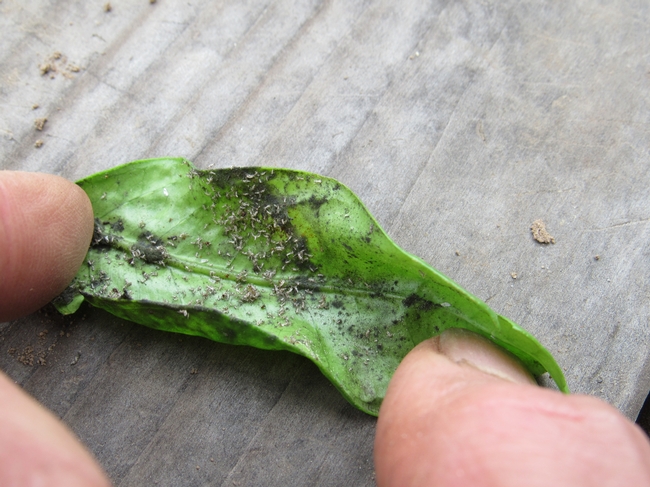Advice for the Home Gardener from the Help Desk of the
UC Master Gardener Program of Contra Costa County

found on underside of leaf
Response from the Help Desk: Thank you for sending the photo of your citrus leaf with what clearly looks like a whitefly infestation. Whiteflies are tiny, flying insects that derive their name from the mealy white wax covering their wings and body. They suck the leaf's sap, which in some cases can cause leaves to curl and/or wilt and drop when populations are large. Whiteflies can be abundant in vegetable, fruit, and ornamental plantings, especially during warm weather.
However, the primary concern with whiteflies is the honeydew they produce. Honeydew excreted by nymphs collects dust and supports the growth of sooty mold, which is the black stuff you see on the leaf in your photo. (Sooty mold does not cause damage to the plant unless it's so heavy it blocks all sunlight from reaching the leaves.) The honeydew however attracts ants, which can "protect" the whiteflies from natural predators which would usually keep the whitefly population under control. These natural predators can also be harmed by the home gardener spraying with broad-range products such as insecticidal soaps.
Management of heavy whitefly infestations is difficult so prevention is best. Removing heavily infested leaves or hosing them with “sharp” water sprays is a good way to get a handle on an infestation. You will need to be vigilant in watching for whiteflies in the future. Since dusty leaves are more attractive to these insects, regularly washing off the plants with water should help a lot. Also, controlling ants will go a long way to allowing the natural predators to do their job. Placing sticky yellow traps (available at garden stores) on the trees (or plants or nearby) can also be used to monitor for whiteflies and will give you a warning that you need to increase your inspections and controls.
Here is more information from UC about whiteflies and their control: http://ipm.ucanr.edu/PMG/PESTNOTES/pn7401.html and also information about ants and their control: http://ipm.ucanr.edu/PMG/PESTNOTES/pn7411.html.
Please do not hesitate to contact us again if we can be of help in your gardening.
Happy gardening!
Help Desk of the UC Master Gardener Program of Contra Costa County (SEH)
Note: The UC Master Gardeners Program of Contra Costa's Help Desk is available year-round to answer your gardening questions. Except for a few holidays, we're open every week, Monday through Thursday for walk-ins from 9:00 am to Noon at 75 Santa Barbara Road, 2d Floor, Pleasant Hill, CA 94523. We can also be reached via telephone: (925) 646-6586, email: ccmg@ucanr.edu, or on the web at http://ccmg.ucanr.edu/Ask_Us/ MGCC Blogs can be found at http://ccmg.ucanr.edu/HortCoCo/ You can also subscribe to the Blog (//ucanr.edu/blogs/CCMGBlog/).